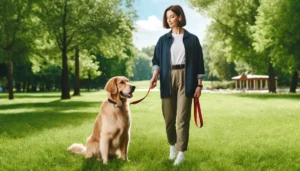Dealing with violent dogs can be difficult, but if you train them properly you can change their behavior and get closer to them. It is important to be patient and consistent and to provide good feedback in response to aggressive behavior. This article discusses several ways you can train a dog to reduce aggression.
Table of Contents
Toggle1. Understand Aggression:
To teach your dog, you must first know why he is aggressive. Fear, the need to protect territory, the desire for control, and even health problems can lead to aggression. Creating a good training plan starts with finding the cause.
2. Professional Evaluation:
The best way to find out why your dog is aggressive is often to seek help from a professional dog trainer or behaviorist. These professionals can carefully evaluate your dog and create a personalized training plan tailored to his or her specific needs.
3. Use Positive Reinforcement:
Positive reinforcement is an effective method of training people because it involves rewarding good behavior to encourage people to do it again. When dealing with aggressive dogs, the best thing you can do is thank them for staying calm and not biting. Rewarding good behavior with treats, praise, and fun allows them to focus on other things.
4. Loss of Sensitivity:
For desensitization to work, you need to slowly and aggressively expose your dog to the things that make him angry. For example, if your dog is mean to other dogs, keep him away and thank him for being calm. Over time, as your dog gets used to it, you can slowly close the distance.
5. Change Conditions:
Changing how your dog thinks about a situation is what counterconditioning is all about. You can make a good link with your triggers by linking them to something tasty, such as a snack or a game. This approach can help you turn a negative emotional response into a positive one.
6. Clicker Training:
Positive reinforcement is used in clicker training, where a sound is used to mark good behavior and then a reward is given. This way you can communicate clearly with your dog and reinforce the exact moments when he behaves non-aggressively.
7. Obedience Training:
By enrolling your dog in obedience classes, you can train him in a structured manner in a safe place. To control and redirect aggressive behavior, teach your dog simple commands such as “sit,” “stay,” and “come here.” Consistent obedience training can make you a leader, which can help alleviate the anger that comes with wanting to be in charge.
8. Use of Distractions:
If something else is going on around you, your dog may not notice the possible cause. You can change the subject and reward good behavior with a toy, treat, or a favorite game. You can slowly increase the level of distraction to reduce the chance of reacting aggressively.
9. Guided Socialization:
For dogs with violent tendencies, socialization should be done slowly and in a controlled manner. Introduce them to new people, animals, and places in a controlled way so they make great memories. In the long term, this can help to teach fear-based violence a lesson.
10. Timeouts:
Setting a timeout is a good way to let people know that being aggressive is not okay. When your dog shows aggression, remove him from the situation and place him in a time-out zone, but do this gently and without becoming angry. This helps them realize that being mean means losing prizes and attention.
11. Consistency:
Consistency is very important when teaching a dog. Set clear rules and standards for your dog and ensure that everyone in the household and anyone caring for the dog adheres to them. Inconsistency can confuse the dog and harm your training.
Conclusion
You must be patient, understanding, and committed to using consistent teaching methods when your dog is aggressive. Professional help, good reinforcement, and a focus on changing how your dog feels can help with long-term behavior change. By using these methods when training your dog, you can build a strong, trusting relationship with him while addressing and controlling his violent behavior.
FAQs
1. What’s wrong with my dog?
There are many reasons why a dog may be aggressive, such as fear, territorial instincts, dominance, or deeper health issues. Finding the cause is important for training to be effective.
2. Can I teach my dog not to be mean to himself?
There are some basic things you can do to help your dog behave better at home, but you should seek the help of a dog trainer or behaviorist to fully understand your dog’s aggression and develop a customized training plan.
3. What is a useful reward and how does it work?
When you reward good behavior with treats, praise, or games, you are using positive reinforcement. This method encourages your dog to repeat good behavior, making him or her less aggressive and more focused on doing good things.
4. What is the process of desensitization through aggression training?
For the desensitization to work, slowly expose your dog to the trigger while praising his calm behavior. This process reduces emotional responses to triggers and leads to emotional calming over time.
5. Is clicker training effective for vicious dogs?
Yes, clicker training is very effective. Clickers allow you to mark the exact moment your dog does what you want. This makes it a very accurate way to reward your dog for good behavior.
6. Can behavioral training help with aggression?
Yes, it is very important to teach your dog obedience. Basic commands like “sit,” “stay,” and “come” put you in the position of being in control, which can deter aggressive behavior that stems from a lack of control and provide you with ways to address and change aggressive behavior.


